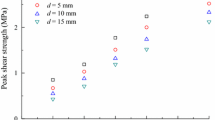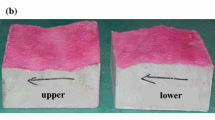Abstract
Rock joint surface roughness, which influences the shear resistance of joints, dictates the stability of rock blocks. However, there is a weakening effect on the shear behavior of a rock joint as it becomes “un-matching” caused by external factors, such as vibration due to nearby blasting, excavation or earthquake. This paper presents an experimental investigation of the shear behavior of artificial rock joints under different matching conditions by direct shear test, modeled by imposing varying magnitude of horizontal dislocation along the shear direction between the upper and lower rock blocks. The peak shear strength decreases with increasing dislocation. However, the effect of dislocation on peak shear strength becomes less pronounced as the normal stress increases. With increasing dislocation, the peak shear displacement increases; the shear stiffness decreases and gradually approaches a constant. The influence of dislocation on shear stiffness is more prominent under a higher applied normal stress. The results also show that the peak shear strength of matching joints is influenced mostly by shear velocity.









Similar content being viewed by others
Abbreviations
- \( {\text{Ave}} \) :
-
Average value
- \( d \) :
-
Horizontal dislocation between the upper and lower rock blocks (mm)
- \( E \) :
-
Young’s modulus (GPa)
- \( I \) :
-
Positive integer, I = 1, 2, 3
- \( {\text{JMC}} \) :
-
Joint matching coefficient
- \( {\text{JRC}} \) :
-
Joint roughness coefficient
- \( {\text{JRC}}_{\text{Ave}} \) :
-
JRC value of joint surface
- \( {\text{JRC}}_{\text{i}} \) :
-
JRC value obtained from the three researchers
- \( {\text{JRC}}_{\text{j}} \) :
-
JRC value of the j-th profile along the shear direction
- \( j \) :
-
Positive integer, j = 1, 2, 3,…, 9
- \( {\text{K}}_{\text{s}} \) :
-
Shear stiffness (MPa/mm)
- \( {\text{L}} \) :
-
Specimen length along the shear direction (mm)
- \( {\text{Max}} \) :
-
Maximum value
- \( {\text{Min}} \) :
-
Minimum value
- \( {\text{SD}} \) :
-
Standard deviation
- \( \tau_{\text{p}} \) :
-
Peak shear strength (MPa)
- \( \varphi_{\text{b}} \) :
-
Basic friction angle of rock joint (°)
- \( \sigma_{\text{c}} \) :
-
Uniaxial compressive strength of model material (MPa)
- \( \sigma_{\text{n}} \) :
-
Normal stress (MPa)
- \( \sigma_{\text{t}} \) :
-
Tensile strength of the model material (MPa)
- \( \upsilon \) :
-
Poisson’s ratio
- \( \rho \) :
-
Density (kg/m3)
References
Barton N (1973) Review of a new shear-strength criterion for rock joints. Eng Geol 7(4):287–332
Barton N (1982) Modeling rock joint behavior from in situ block tests: implications for nuclear waste repository design. Office of Nuclear Waste Isolation, Columbus, OH
Barton N, Choubey V (1977) The shear strength of rock joints in theory and practice. Rock Mech 10(1–2):1–54
Grasselli G, Egger P (2003) Constitutive law for the shear strength of rock joints based on three-dimensional surface parameters. Int J Rock Mech Min Sci 40(1):25–40
ISRM (1981) Rock characterization, testing and monitoring—ISRM suggested methods. In: Brown ET (ed) Suggested methods for the quantitative description of discontinuities in rock masses. Pergamon, Oxford, pp 3–52
Kulatilake PHSW, Shou G, Huang TH et al (1995) New peak shear strength criteria for anisotropic rock joints. Int J Rock Mech Min Sci Geomech Abstr 32(7):673–697
Ladanyi B, Archambault G (1969) Simulation of shear behavior of a jointed rock mass. In: Proceedings of the 11th US symposium on rock mechanics (USRMS), Berkeley, California, pp 105–125
Oh J, Kim GW (2010) Effect of opening on the shear behavior of a rock joint. Bull Eng Geol Environ 69(3):389–395
Tang ZC (2013) Mechanical behavior of rock joint under different contact state and columnar jointed rock mass (in Chinese with English abstract). PhD thesis, Tongji University, Shanghai
Tang ZC, Liu QS, Xia CC et al (2014) Mechanical model for predicting closure behavior of rock joints under normal stress. Rock Mech Rock Eng 47(6):2287–2298
Xia CC, Tang ZC, Xiao WM et al (2014) New peak shear strength criterion of rock joints based on quantified surface description. Rock Mech Rock Eng 47(2):387–400
Zhao J (1997a) Joint surface matching and shear strength part A: joint matching coefficient (JMC). Int J Rock Mech Min Sci 34(2):173–178
Zhao J (1997b) Joint surface matching and shear strength part B: JRC-JMC shear strength criterion. Int J Rock Mech Min Sci 34(2):179–185
Acknowledgments
The first author gratefully acknowledges the support from the Natural Science Foundation of China under project 41402247, the National Basic Research Program of China (973 Program) under project 2014CB046904, the opening fund of State Key Laboratory of Geohazard Prevention and Geoenvironment Protection under project SKLGP2014K018 and the 55th China Postdoctoral Science Foundation under project 2014M550407. The direct shear tests were performed by the first author (supported by the Natural Science Foundation of China under project 40972178) at the Tongji University during the period of studying for his PhD degree, and thanks are given to Prof. Caichu Xia. The first author wishes to thank Mr Yinglong Song for preparing the model specimens and assisting the direct shear tests. The first and fourth authors acknowledge the support by the Singapore Academic Research Fund Tier 1 Grant (RG112/14). The authors would also like to express their appreciation for the helpful comments and suggestions from an anonymous reviewer.
Author information
Authors and Affiliations
Corresponding author
Additional information
Louis Ngai Yuen Wong was formerly with School of Civil and Environmental Engineering, Nanyang Technological University.
Rights and permissions
About this article
Cite this article
Tang, Z.C., Huang, R.Q., Liu, Q.S. et al. Effect of contact state on the shear behavior of artificial rock joint. Bull Eng Geol Environ 75, 761–769 (2016). https://doi.org/10.1007/s10064-015-0776-z
Received:
Accepted:
Published:
Issue Date:
DOI: https://doi.org/10.1007/s10064-015-0776-z




